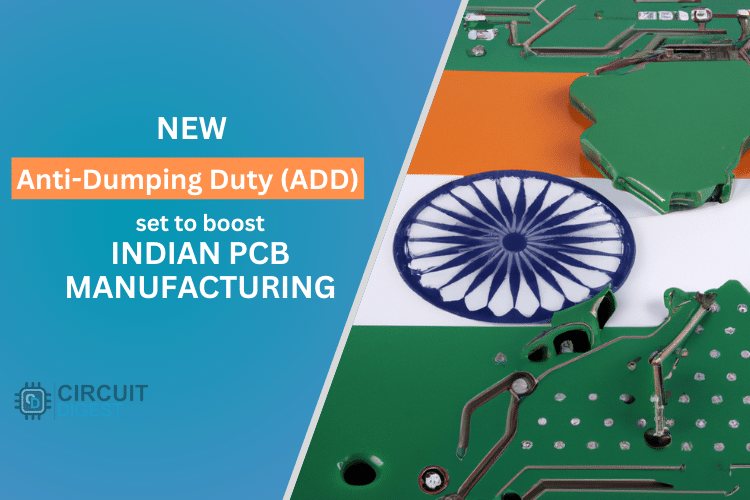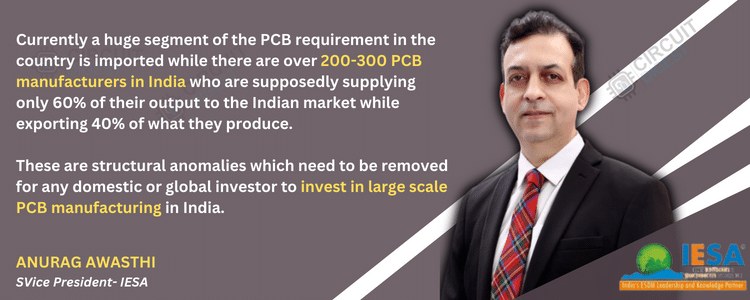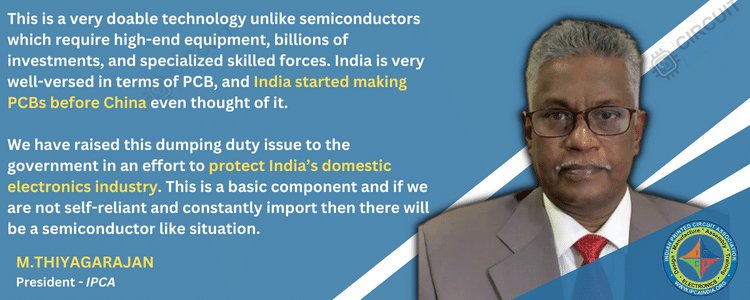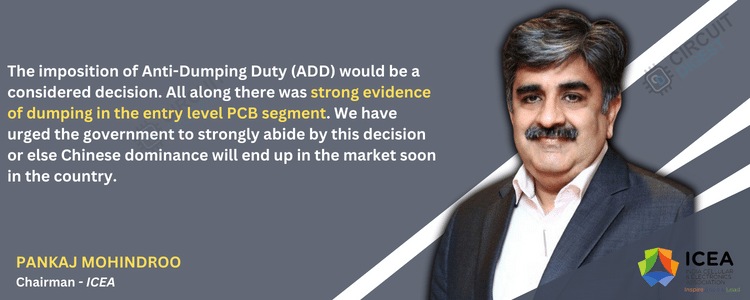
- India imposes 30% anti-dumping duty on bare PCBs from China and Hong Kong, safeguarding domestic electronics manufacturing
- Manufacturers and associations support the move, emphasizing the need to strengthen PCB manufacturing for self-reliance
- Stakeholders stress investments in infrastructure and technology to capitalize on India's electronics industry growth
India's electronics industry is rapidly growing, targeting $300 billion in total production and $125 billion in exports by 2026. However, achieving self-reliance requires bolstering the major component ecosystem. Currently, India relies heavily on imports, particularly from China and Vietnam, for crucial components. The PCB market in India reached $4.5 billion in 2022 and is projected to reach $11.8 billion by 2028, highlighting its significance. PCBs serve as vital components connecting electronic parts in various consumer electronics and IT hardware products. To support industry growth, government intervention is necessary through initiatives like a separate Production Linked Incentive (PLI) scheme and subsidies for equipment, power, and R&D. As India approaches its production target, an estimated $150 billion worth of components, including PCBs, will be required.
Feeling the heat of the importance of boosting PCB manufacturing, the Finance Minister, Nirmala Sitharaman, after several rounds of discussions, has finally imposed a 30 percent anti-dumping duty (ADD) for a period of five years on bare PCBs which are imported from China and Hong Kong. Both the manufacturers and the industry associations welcomed this move by the government. They feel that although the manufacturing of PCBs is complex, it is not as difficult like making semiconductors. India is very well-poised to manufacture it on a large-scale, both for its own consumption and for the rest of the world.

Although the ADD tariff would prove to be optimistic for the Indian PCB industry, there are loads of challenges that require countermeasures. According to last year’s data, around 85-90 percent of PCBs were imported from China. In an exclusive interaction with Circuit Digest, Sanjay Aggarwal, managing director of Globe Capacitors, said that a huge chunk of PCB requirements are imported, which is not sustainable and makes us susceptible to fluctuating global crises. PCB manufacturing requires high-quality infrastructure and is characterized by a very high output ratio of 1:1 or 1:5. It has a complex supply chain, and the equipment required for its manufacturing are very expensive.
Protecting Domestic Industry: The Need for Imposing Duties on Imported PCBs
In an effort to safeguard India’s domestic electronics industry, the Indian Printed Circuit Association notified the government in December 2022 that there is an ongoing ‘Threat to Material Injury” due to massive dumping of components such as bare PCBs from China and Hong Kong. Therefore, there is a significant requirement of anti-dumping duty on the imported PCBs. After analyzing and investigating the situation thoroughly, the Directorate General of Trade Remedies (DGTR), the right arm of the Commerce ministry, recommended anti-dumping duty on imported PCBs in January 2024. The authorities have added that the duty will affect the availability of electronic items to the consumers. During the course of the investigation, the DGTR revealed that PCB imports from China PR and Hong Kong were sold below fair market rates, causing tangible harm to the domestic sector. Under the authority vested by sections 9A(1) and 9A(5) of the Customs Tariff Act, the Central Government authorized anti-dumping duties on specified PCB imports. These duties, calculated as a percentage of the CIF value of imported PCB goods, aim to counter the adverse impact of PCB dumping and protect domestic industry interests.
Applauding the government’s anti-dumping duty on imported PCBs, Murali Srinivasa, founder, CEO at LionCircuits, told Circuit Digest, “The Indian and China’s PCB manufacturing markets are not on the same level. What the Indian government has now done will boost and elevate confidence among the country’s manufacturers. The Chinese government gives a lot of subsidies in terms of water and electricity, which is an important requirement for the manufacturing of PCBs. This is why, in the last 10-15 years, China has evolved its manufacturing ecosystem. Because of price cuts from China, Indian PCB makers have suffered a lot. But, this anti-dumping duty is not going to be a long-term solution. This is just for five years, and within this time frame, the PCB manufacturers will have to become globally competitive. At Lion’s Circuit, we are also trying to become globally competitive independent of the subsidies.”

“What China is doing is not a realistic market scenario. In this situation, all the Indian OEMs, product manufacturers, and R&D houses were left with no option, but to procure raw materials from China. This is because there are no Indian manufacturers who can offer electronic goods at competitive prices. At Lion’s Circuits, we have launched a ‘Make-in-India’ plan, where we are offering two-layered boards for 10 dollars. India should have the ability to manufacture a two-layer PCB board in just 24 hours. We have to increase production and make sure that processes and factories are running smoothly, backed by cutting-edge equipment. In 2, 4, and 6 layered boards, which is the largest market both in terms of transactions and volume are imposed with the import duty,” added Murali.
This decision underscores the government's commitment to fair trade practices and ensuring a level playing field for all stakeholders in the PCB market. According to the official spokesperson of DGTR, "while the domestic industry has been able to increase the selling price at present due to concentration on profitable segments, the continued imports at dumped prices have not allowed it to increase the sales beyond those segments and pose a threat of price suppression and depression on the domestic industry." Initially, the duty recommended was in the range of 8.23 percent to 75.72 percent of the cost, insurance, and freight (CIF) value. When any country is under the impression that its domestic industries are being largely impacted due to an escalation in below-cost imports, then anti-dumping investigations are carried out and certain duties are imposed following the instructions of the World Trade Organization (WTO).
The PCBs with more than six layers and the populated ones were not included in the investigation. According to the government report, $478 million worth of PCBs were imported from Hong Kong and China during April-October 2023. According to the IPCA, there are around 200 SME category PCB makers in India whose businesses are largely impacted due to the huge volume of dumping for more than four years. Therefore, the Indian PCB industry needs to ramp up and compete with global industry to support local manufacturing and EMS companies. This is vital, if India wants to benefit from this measure taken by the government, or else, it may have a negative impact due to the rise in manufacturing costs.
The PCB industry in India faces tough competition from neighboring countries such as China, Hong Kong, and Taiwan, which have a vast history of PCB manufacturing, benefits from top-notch technology, decreased production costs, and economies of scale. The infrastructure and the supply chain is quite insufficient, which is posing a huge impediment to its manufacturing. Most importantly, the power supply is highly infrequent and is not subsidized. Then, there is a shortage of sophisticated machinery and equipment, which are very costly for Indian SMEs to procure. For a very long time, manufacturers and industry bodies have been urging the government to come up with an additional scheme and incentives for the equipment and machinery segment.
Sanjay Agarwal added that as per an exclusive 'ELCINA PCB Ecosystem Development Report 2023', India requires adding innovative large-scale PCB plants addressing 5 million Sq. Meters of ML and 2 Million Sq. meters of Flex/Rigid-Flex units in the coming five years. Currently, the nation requires seven large PCB factories equipped with 1 Mn. Sq. M plant capacity. Moreover, it requires an investment of Rs 7,000 crores that will provide a yearly revenue of Rs 10,500 crore along with a direct employment of 7000 , and 35,000 employment indirectly in the value chain.
Anti-dumping Duty to boost Indian SMEs and PCB Industry claims Industry Experts
This is a strategic move, which is welcomed both by the PCB manufacturers and the industry bodies. According to them, ADD is not a long-term solution, this is also a strong pillar for the PCB industry in India. Anti dumping measures are promulgated to ensure free trade and create a level playing field for a particular industry segment. It is not a measure to restrict imports or to accrue an increase in the cost of a particular product. To this end, the policy is well thought out and does not look at things from a myopic perspective. Let’s find out below what the industry bodies told Circuit Digest exclusively:

Rajoo Goel, Secretary-General, Electronics Industries Association of India (ELCINA)
Anti-dumping duty on Bare PCBs is a definitive action for preventing dumping of this key electronic component in the Indian market. Dumping from China has been suspected for a long time. The government abstained from this tough action as the electronics industry was divided because the users of PCBs expressed concerns about the escalation in manufacturing cost. However, the ADD has been limited to PCBs upto 6 layers, and several high end PCBs have been exempt. This effectively means that less than 70 percent of the market by value is being protected, and this will decline further to below 50 percent in 3-4 years as technology and products upgrade. However, the growth and opportunity are immense.

Anurag Awasthi, Vice President, India Electronics and Semiconductors Association (IESA)
India is now aiming for Atmanirbhar Bharat in electronics manufacturing, in which, PCBs are the fulcrum. Currently a huge segment of the PCB requirement in the country is imported, while there are over 200-300 PCB manufacturers in India who are supposedly supplying only 60 percent of their output to the Indian market, while exporting 40 percent. The current anti-dumping duty levies are specific to those companies and sources that apparently supply well below the raw material cost in India. These are structural anomalies, which need to be removed for any domestic or global investor to invest in large scale PCB manufacturing in India. We have to learn from the Koreans, who only source from Korean brands - similarly, Indian EMS companies need to learn and have a mindset change to source from India as well. While there is no visible scarcity in terms of capacity, the need to factor in slightly more costs to fight against dumping from other nations should be considered.

M Thiyagarajan, President, Indian Printed Circuit Association (IPCA)
The PCB is the backbone of any electronic product. We have raised this dumping duty issue with the government in an effort to protect India’s domestic electronics industry. This is a basic component, and if we are not self reliant and constantly import, then there will be a semiconductor like situation. This is a very doable technology, unlike semiconductors which require high-end equipment, billions of investment, and specialized skilled forces. India is very well-versed in terms of PCBs, and we have started making PCBs much before China even thought of it. Initially, there will be a few shortages of PCBs from this decision, but we will find a solution like we did during COVID. For instance, there was a time when India used to import huge amounts of food grains from other countries, and today we have excess as the government has paid attention to it. We are not against FDI, we are suggesting they make products in India and then sell it in the country.

Pankaj Mohindroo, Chairman, India Cellular & Electronics Association (ICEA)
The imposition of Anti-dumping Duty (ADD) would be a considered decision. All along, there was strong evidence of dumping in the entry level PCB segment. We have urged the government to strongly abide by this decision or else Chinese dominance will never come to an end. India is now growing very rapidly, and if this pace is continued, we will definitely set a benchmark in the global electronics industry.





